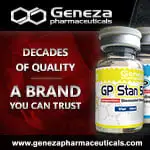indy69camaro said:absolutely positively NOT
Treatment with oxandrolone and the durability of effects in older men
E. Todd Schroeder, Ling Zheng, Kevin E. Yarasheski, Dajun Qian, Yolanda Stewart, Carla Flores, Carmen Martinez, Michael Terk and Fred R. Sattler
We investigated the effects of the anabolic androgen, oxandrolone, on lean body mass (LBM), muscle size, fat, and maximum voluntary muscle strength, and we determined the durability of effects after treatment was stopped. Thirty-two healthy 60- to 87-yr-old men were randomized to receive 20 mg oxandrolone/day (n = 20) or placebo (n = 12) for 12 wk. Body composition [dual-energy X-ray absorptiometry (DEXA), magnetic resonance imaging, and 2H2O dilution] and muscle strength [1 repetition maximum (1 RM)] were evaluated at baseline and after 12 wk of treatment; body composition (DEXA) and 1-RM strength were then assessed 12 wk after treatment was discontinued (week 24). At week 12, oxandrolone increased LBM by 3.0 ± 1.5 kg (P < 0.001), total body water by 2.9 ± 3.7 kg (P = 0.002), and proximal thigh muscle area by 12.4 ± 8.4 cm2 (P < 0.001); these increases were greater (P < 0.003) than in the placebo group. Oxandrolone increased 1-RM strength for leg press by 6.7 ± 6.4% (P < 0.001), leg flexion by 7.0 ± 7.8% (P < 0.001), chest press by 9.3 ± 6.7% (P < 0.001), and latissimus pull-down exercises by 5.1 ± 9.1% (P = 0.02); these increases were greater than placebo. Oxandrolone reduced total (-1.9 ± 1.0 kg) and trunk fat (-1.3 ± 0.6 kg; P < 0.001), and these decreases were greater (P < 0.001) than placebo. Twelve weeks after oxandrolone was discontinued (week 24), the increments in LBM and muscle strength were no longer different from baseline (P > 0.15). However, the decreases in total and trunk fat were sustained (-1.5 ± 1.8, P = 0.001 and -1.0 ± 1.1 kg, P < 0.001, respectively). Thus oxandrolone induced short-term improvements in LBM, muscle area, and strength, while reducing whole body and trunk adiposity. Anabolic improvements were lost 12 wk after discontinuing oxandrolone, whereas improvements in fat mass were largely sustained.
Effects of Androgen Therapy on Adipose Tissue and Metabolism in Older Men
E. Todd Schroeder, Ling Zheng, Michelle D. Ong, Carmen Martinez, Carla Flores, Yolanda Stewart, Colleen Azen and Fred R. Sattler
We investigated the effects of oxandrolone on regional fat compartments and markers of metabolism. Thirty-two 60- to 87-yr-old men (body mass index, 28.1 ± 3.4 kg/m2) were randomized to oxandrolone (20 mg/d; n = 20) or matching placebo (n = 12) treatment for 12 wk. Oxandrolone reduced total (–1.8 ± 1.0 kg; P < 0.001), trunk (–1.2 ± 0.6 kg; P < 0.001), and appendicular (–0.6 ± 0.6 kg; P < 0.001) fat, as determined by dual energy x-ray absorptiometry. The changes in total and trunk fat were greater (P < 0.001) than the changes with placebo. By magnetic resonance imaging, visceral adipose tissue decreased (–20.9 ± 12 cm2; P < 0.001), abdominal sc adipose tissue (SAT) declined (–10.7 ± 12.1 cm2; P = 0.043), the ratio VAT/SAT declined from 0.57 ± 0.23 to 0.49 ± 0.19 (P = 0.002), and proximal and distal thigh SC fat declined [–8.3 ± 6.7 cm2 (P < 0.001) and –2.2 ± 3.0 kg (P = 0.004), respectively]. Changes in proximal and distal thigh SC fat with oxandrolone were different than with placebo (P = 0.018 and P = 0.059). A marker of insulin sensitivity (quantitative insulin sensitivity check index) improved with oxandrolone by 0.0041 ± 0.0071 (P = 0.018) at study wk 12. Changes in total fat, abdominal SAT, and proximal extremity SC fat were correlated with changes in fasting insulin from baseline to study wk 12 (r 0.45; P < 0.05). Losses of total fat and SAT were greater in men with baseline testosterone of 10.4 nmol/liter or less ( 300 ng/dl) than in those with higher levels [–2.5 ± 1.1 vs. –1.5 ± 0.8 kg (P = 0.036) and –24.1 ± 14.3 vs. –2.9 ± 21.3 cm2 (P = 0.03), respectively]. Twelve weeks after discontinuing oxandrolone, 83% of the reductions in total, trunk, and extremity fat by dual energy x-ray absorptiometry scanning were sustained (P < 0.02). Androgen therapy, therefore, produced significant and durable reductions in regional abdominal and peripheral adipose tissue that were associated with improvements in estimates of insulin sensitivity. However, high-density lipoprotein cholesterol decreased by –0.49 ± 0.21 mmol/liter and directly measured low-density lipoprotein cholesterol increased by 0.57 ± 0.67 mmol/liter and non-high-density lipoprotein cholesterol increased by 0.54 ± 0.97 mmol/liter (P < 0.03 for each) during treatment with oxandrolone; these changes were largely reversible. Thus, therapy with an androgen that does not adversely affect lipids may be beneficial for some components of the metabolic syndrome in overweight older men with low testosterone levels.


 Please Scroll Down to See Forums Below
Please Scroll Down to See Forums Below 










